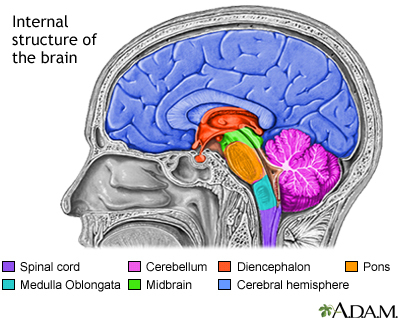Definition
A facial tic is a repeated spasm, often involving the eyes and muscles of the face.
Alternative Names
Tic - facial; Mimic spasm
Causes
Tics most often occur in children, but may last into adulthood. Tics occur 3 to 4 times as often in boys as girls. Tics may affect as many as one quarter of all children at some time.
The cause of tics is unknown, but stress appears to make tics worse.
Short-lived tics (transient tic disorder) are common in childhood.
A chronic motor tic disorder also exists. It may last for years. This form is very rare compared to the common short-lived childhood tic. Tourette syndrome is a separate condition in which tics are a major symptom.
Symptoms
Tics may involve repeated, uncontrolled spasm-like muscle movements, such as:
- Eye blinking
- Grimacing
- Mouth twitching
- Nose wrinkling
- Squinting
Repeated throat clearing or grunting may also be present.
Exams and Tests
The health care provider will usually diagnose a tic during a physical examination. No special tests are needed. In rare cases, an EEG may be done to look for seizures, which can be the source of tics.
Treatment
Short-lived childhood tics are not treated. Calling the child's attention to a tic may make it worse or cause it to continue. A non-stressful environment can make tics occur less often, and help them go away more quickly. Stress reduction programs or cognitive behavioral intervention may also be helpful.
If tics severely affect a person's life, medicines may help control them.
Outlook (Prognosis)
Simple childhood tics should go away on their own over a period of months. Chronic tics may continue for a longer period of time.
Possible Complications
In most cases, there are no complications.
When to Contact a Medical Professional
Contact your provider for an appointment if tics:
-
Affect many muscle groups
-
Are persistent
-
Are severe
Prevention
Many cases cannot be prevented. Reducing stress may be helpful. Sometimes, counseling can help your child learn how to cope with stress.
References
Ryan CA, Walter HJ, DeMaso DR. Motor disorders and habits. In: Kliegman RM, St. Geme JW, Blum NJ, Shah SS, Tasker RC, Wilson KM, eds. Nelson Textbook of Pediatrics. 21st ed. Philadelphia, PA: Elsevier; 2020:chap 37.
Tochen L, Singer HS. Tics and Tourette syndrome. In: Swaiman KF, Ashwal S, Ferriero DM, et al, eds. Swaiman's Pediatric Neurology: Principles and Practice. 6th ed. Philadelphia, PA: Elsevier; 2017:chap 98.


